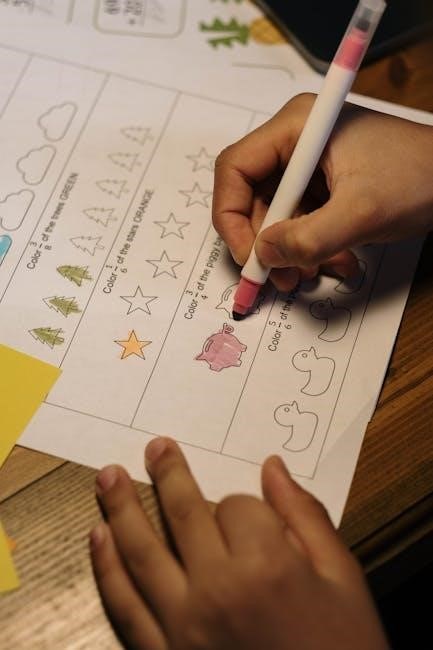Codependency is a behavioral pattern where individuals prioritize others’ needs over their own, often linked to addiction. Worksheets offer practical tools for self-reflection and personal growth.
1.1 Definition of Codependency
Codependency is a dysfunctional relationship pattern where individuals prioritize others’ needs, emotions, and behaviors over their own, often leading to emotional dependence. It involves enabling behaviors, such as people-pleasing and sacrificing personal boundaries, to maintain harmony or avoid abandonment. Codependency frequently arises in relationships with addicts but can exist in any dyadic relationship. It is characterized by a loss of identity, low self-worth, and difficulty in expressing personal needs. Worksheets on codependency help individuals identify these patterns and understand how they impact their well-being, serving as a foundational tool for recovery and growth.
1.2 Understanding Codependent Relationships
Codependent relationships are dynamic where one person enables another’s harmful behaviors, often to maintain a sense of control or avoid abandonment; These relationships are marked by emotional dependence, people-pleasing, and sacrificing personal boundaries. Codependency frequently arises in partnerships involving addiction but can occur in any relationship. It fosters an unhealthy interdependence, where one individual prioritizes the other’s needs over their own, leading to a loss of personal identity and autonomy. Worksheets on codependency help individuals recognize these patterns and understand how they contribute to relationship imbalances, providing a structured approach to addressing and transforming these dynamics.
Symptoms of Codependency
Common symptoms include emotional dependence, fear of abandonment, enabling behaviors, and difficulty setting boundaries. Worksheets help identify these patterns for personal awareness and growth.
2.1 Emotional Dependence
Emotional dependence is a core symptom of codependency, where individuals rely heavily on others for validation and self-worth. This can lead to feelings of helplessness and an inability to make decisions independently. Worksheets designed for codependency often include exercises that help identify and challenge these patterns. By reflecting on emotional triggers and responses, individuals can gain insight into how their reliance on others impacts their mental health. These tools encourage self-awareness and provide practical steps to develop healthier emotional habits. Addressing emotional dependence is a crucial step in overcoming codependency, as it fosters independence and self-confidence.
2.2 Fear of Abandonment
Fear of abandonment is a pervasive symptom of codependency, often rooted in deep-seated insecurities and past experiences. This fear drives individuals to cling to relationships, even unhealthy ones, to avoid feeling rejected or alone. Worksheets on codependency often include exercises to explore and address this fear, helping individuals recognize how it influences their behaviors and decisions. By identifying triggers and challenging negative beliefs, individuals can begin to build a sense of security and independence. These tools encourage self-reflection and provide practical strategies to manage abandonment fears, fostering healthier relationship dynamics and personal growth. Addressing this fear is essential for breaking the cycle of codependency.
2.3 Enabling Behaviors
Enabling behaviors are actions that unintentionally support harmful patterns in relationships, often reinforcing codependency. These behaviors, such as covering up for a partner’s addiction or consistently putting others’ needs first, can prevent personal and relationship growth. Worksheets on codependency help individuals identify and challenge enabling behaviors by promoting self-awareness and accountability. They provide exercises to distinguish between supportive and enabling actions, encouraging healthier ways to contribute to relationships. Addressing enabling behaviors is crucial for breaking the cycle of codependency, as it allows individuals to establish balance and foster mutual respect. By recognizing these patterns, individuals can develop strategies to stop enabling and focus on their own well-being.

Codependency in Relationships
Codependency often arises in relationships involving addiction, where one person enables harmful behaviors. Worksheets help address communication challenges and emotional dependence, fostering healthier dynamics and personal growth.
3.1 Impact on Communication
Codependency significantly affects communication, often leading to passive or aggressive expressions rather than open, honest dialogue. Individuals may struggle to express their needs or set boundaries, fearing rejection or abandonment. This can result in misunderstandings and unresolved conflicts. Worksheets can help identify these patterns by providing exercises that promote self-awareness and effective communication strategies. For example, they might include prompts to practice assertive statements or reflect on past interactions. By addressing these issues, worksheets enable individuals to develop healthier communication habits, fostering more balanced and fulfilling relationships. Improved communication is a crucial step in overcoming codependency and building stronger connections with others.
3.2 Effects on Personal Boundaries
Codependency often leads to blurred or nonexistent personal boundaries, causing individuals to overextend themselves to meet others’ needs. This can result in emotional and mental exhaustion, as they prioritize others’ well-being over their own. Worksheets designed to address codependency frequently include exercises aimed at identifying and reestablishing healthy boundaries. These tools help individuals recognize where their boundaries have been compromised and provide actionable steps to reclaim them. By setting clear limits, individuals can reduce emotional strain and foster more balanced relationships. Worksheets also encourage self-reflection on how boundary issues may stem from deeper emotional patterns, such as fear of abandonment or low self-worth.

The Role of Worksheets in Addressing Codependency
Codependency worksheets are practical tools for identifying behaviors, setting boundaries, and improving self-worth. They guide individuals through self-reflection and personal growth.
4.1 Identifying Codependent Behaviors
Codependent behaviors often manifest as excessive emotional dependence or enabling patterns. Worksheets designed for codependency help individuals recognize these traits through guided reflection and exercises. By exploring personal relationships and emotional responses, users can identify harmful cycles. Common patterns include prioritizing others’ needs over one’s own, fear of abandonment, and difficulty in setting boundaries. These exercises encourage self-awareness, allowing individuals to acknowledge how their actions contribute to codependent dynamics. Understanding these behaviors is the first step toward breaking the cycle and fostering healthier relationships. Worksheets provide a structured approach to pinpointing these tendencies, making it easier to address them effectively in therapy or personal growth journeys.
4.2 Setting Healthy Boundaries
Setting healthy boundaries is a critical step in addressing codependency. Worksheets designed for this purpose provide practical tools to help individuals establish and communicate limits effectively. Through guided exercises, users can identify areas where boundaries are lacking or overly rigid. These tools encourage reflection on personal values and needs, empowering individuals to express their expectations clearly. Boundary-setting exercises often include prompts to define emotional and physical limits, practice assertive communication, and develop consequences for when boundaries are crossed. By working through these activities, individuals can break harmful patterns and cultivate healthier, more balanced relationships. This process is essential for rebuilding self-worth and fostering mutual respect in personal and professional connections.
4.3 Improving Self-Worth
Improving self-worth is a vital aspect of overcoming codependency. Worksheets designed for this purpose offer exercises to help individuals recognize and challenge negative self-perceptions. These tools often include activities such as self-affirmation practices, identifying personal strengths, and reflecting on past achievements. By focusing on self-worth, individuals can shift their reliance on others for validation and develop an internal sense of value. Worksheets may also guide users in setting realistic goals and celebrating progress, fostering resilience and confidence. Addressing self-worth is essential for breaking the cycle of codependency and cultivating healthier, more fulfilling relationships. These exercises empower individuals to embrace their worth independently of external factors.

Benefits of Using Codependency Worksheets
Codependency worksheets offer enhanced self-awareness, providing practical tools for personal growth. They guide individuals in identifying patterns, setting boundaries, and improving self-worth, fostering healthier relationships and emotional resilience.
5.1 Enhanced Self-Awareness
Codependency worksheets are designed to help individuals gain a deeper understanding of their thoughts, feelings, and behaviors. By engaging with these tools, users can identify patterns of emotional dependence and enabling behaviors that contribute to codependent relationships. Enhanced self-awareness allows individuals to recognize how their self-worth is often tied to others’ approval, hindering personal growth. These worksheets guide users through reflective exercises, encouraging them to explore their emotional triggers and the root causes of codependent tendencies. This increased self-awareness is the first step toward breaking free from unhealthy dynamics, enabling individuals to develop healthier communication and relationship patterns. Regular use of these tools fosters a stronger sense of self and emotional resilience.
5.2 Practical Tools for Change
Codependency worksheets provide actionable strategies for personal transformation, offering structured exercises to address specific challenges. These tools help individuals set clear boundaries, practice self-care, and improve communication skills. By completing activities like boundary-setting exercises or self-esteem building tasks, users can apply practical solutions to real-life situations. Worksheets also encourage accountability and consistency, essential for lasting change. They serve as a roadmap, guiding individuals through each step of their journey toward healthier relationships and emotional independence. Regular use of these resources empowers users to break free from codependent patterns, fostering personal growth and long-term emotional well-being.

Common Types of Codependency Worksheets
Popular worksheet types include boundary-setting exercises, self-esteem builders, and emotional awareness activities, designed to help individuals identify and change codependent behaviors effectively.
6.1 Boundary Setting Exercises
Boundary-setting exercises are essential tools in codependency worksheets, helping individuals establish and communicate personal limits. These exercises guide users to identify healthy boundaries, fostering balanced relationships by preventing overcommitment and under-participation. They often include prompts to list personal limits, practice assertive communication, and define consequences for boundary violations. Such activities empower individuals to recognize and honor their emotional and mental boundaries, promoting self-respect and mutual respect in relationships. By clarifying what is and isn’t acceptable, these exercises create awareness of past boundary violations and provide a roadmap for future interactions. Regular practice can lead to lasting changes in communication and relationship dynamics, enhancing overall well-being and independence.
6.2 Self-Esteem Building Activities
Self-esteem building activities in codependency worksheets focus on fostering confidence and self-worth. These exercises often include affirmations, journaling prompts, and self-reflection questions to help individuals recognize their strengths and value. By addressing negative self-talk and identifying personal achievements, these activities empower users to develop a healthier self-image. They also encourage setting realistic goals and celebrating progress, which strengthens resilience and independence. Many worksheets incorporate exercises like listing positive traits or rewriting self-critical thoughts, providing practical steps to rebuild self-esteem. These tools are particularly effective for those struggling with codependency, as they help shift the focus from others’ needs to personal growth and self-care.
How to Effectively Use Codependency Worksheets
Use codependency worksheets by identifying behaviors, setting boundaries, and practicing self-reflection. Consistency and tracking progress enhance their effectiveness in fostering personal growth and healthier relationships.
7.1 Creating a Personalized Plan
Creating a personalized plan with codependency worksheets involves assessing your current behaviors and setting specific, achievable goals. Start by identifying patterns of emotional dependence or enabling behaviors. Use worksheets to explore triggers and underlying causes. Next, outline actionable steps to address these issues, such as setting boundaries or practicing self-care. Incorporate practical exercises, like boundary-setting prompts or self-reflection prompts, to guide your progress. Regularly review and adjust your plan to ensure it aligns with your growth. Tracking progress and celebrating small victories helps maintain motivation. A tailored approach ensures the worksheets address your unique needs, fostering a more effective journey toward healthier relationships and self-worth.
7.2 Tracking Progress Over Time
Tracking progress over time is crucial for lasting change when addressing codependency. Regularly reviewing completed worksheets helps identify improvements and areas needing attention. By documenting insights, feelings, and behaviors, individuals can visualize their growth and stay motivated. Celebrating small victories reinforces positive changes, while acknowledging setbacks provides opportunities for learning. Over time, patterns in thought and behavior become clearer, allowing for more targeted efforts. This process fosters accountability and self-awareness, which are essential for overcoming codependency. Consistently updating and reflecting on progress ensures the journey remains focused and meaningful, ultimately leading to healthier relationships and a stronger sense of self.

Codependency Tests and Quizzes
Online codependency tests and quizzes are tools to assess tendencies and behaviors. They help individuals identify patterns and guide them toward recovery and healthier relationships.
8.1 Assessing Codependent Tendencies
Assessing codependent tendencies involves recognizing patterns of emotional dependence and enabling behaviors. Quizzes and tests provide insights into self-sacrifice, fear of abandonment, and difficulty in setting boundaries. These tools help individuals evaluate their relationships and personal well-being. By identifying these tendencies, individuals can take the first steps toward recovery. Worksheets and guided exercises complement these assessments, offering practical steps to address codependency. Understanding these behaviors is crucial for fostering healthier connections and improving self-worth. Early detection through such tools can lead to meaningful changes and personal growth.

Strategies to Overcome Codependency
Effective strategies involve setting boundaries, practicing self-care, and engaging in therapy. Worksheets guide individuals in identifying patterns and building healthier relationships, promoting personal growth and independence.
9.1 Setting Boundaries
Setting boundaries is a critical step in overcoming codependency. It involves clearly defining and communicating your limits to protect your emotional and mental well-being. Codependency worksheets often include exercises to help identify and assert these boundaries effectively. By establishing clear expectations, individuals can reduce emotional dependency and foster healthier relationships. Worksheets guide users in practicing assertive communication and understanding the importance of “no” without guilt. This process helps break the cycle of enabling behaviors and promotes mutual respect. Regularly revisiting and reinforcing these boundaries ensures long-term personal growth and emotional balance. Through boundary-setting exercises, individuals can reclaim their autonomy and build more fulfilling connections.
9.2 Self-Care Practices
Self-care is essential for breaking the cycle of codependency. Worksheets often include exercises that guide individuals in prioritizing their own needs and emotions. By focusing on self-care, individuals can reduce their reliance on others for validation and happiness. Common practices include journaling, mindfulness, and self-compassion. Worksheets help users identify areas where they neglect their own well-being and provide tools to cultivate healthier habits. Regular self-care fosters emotional resilience and independence, making it easier to maintain boundaries. Over time, these practices empower individuals to shift their focus from others’ needs to their own, promoting a balanced and fulfilling life free from codependent patterns.

Building Healthy Boundaries
Building healthy boundaries is a cornerstone of overcoming codependency. Worksheets designed for this purpose help individuals identify and communicate their limits effectively. By setting clear boundaries, individuals can protect their emotional and mental well-being while fostering healthier relationships. Worksheets often include exercises that guide users in recognizing where they may overextend themselves and how to assert their needs respectfully. Practicing boundary-setting helps break the cycle of people-pleasing and enables individuals to prioritize their own needs. Over time, this empowers them to maintain balanced relationships and reduce feelings of resentment or burnout. Healthy boundaries are a key step toward emotional resilience and independence.
Improving Self-Worth
Improving self-worth is essential for individuals struggling with codependency. Worksheets designed for this purpose often include exercises that help users identify negative self-talk, challenge unhelpful beliefs, and cultivate self-compassion. By focusing on personal strengths and accomplishments, individuals can rebuild their confidence and develop a more positive self-image. Codependency often leads to a lack of self-care, but worksheets provide practical tools to prioritize self-love and self-respect. Activities such as affirmations, journaling, and self-assessment help individuals recognize their value and break free from dependency on others for validation. Over time, these practices foster emotional resilience and empower individuals to maintain healthier, more balanced relationships. Improving self-worth is a critical step toward lasting personal growth and well-being.
The Role of Professional Help
Professional help plays a vital role in addressing codependency, complementing the use of worksheets. Therapists and counselors specialize in identifying and breaking harmful patterns, offering personalized strategies for recovery. They provide a safe space for individuals to explore their emotions and develop healthier communication skills. Worksheets, when used alongside therapy, can enhance self-awareness and accountability. Mental health professionals often recommend specific exercises tailored to an individual’s needs, ensuring a comprehensive approach to healing. Additionally, support groups led by professionals offer community and shared experiences, further enriching the recovery process. Seeking expert guidance is a powerful step toward overcoming codependency and achieving emotional freedom.

Recommended Books on Codependency
Several books are highly recommended for understanding and overcoming codependency. “Codependent No More” by Melody Beattie is a classic, offering insights into breaking free from unhealthy patterns. “The Language of Letting Go” by the same author provides daily affirmations for healing. “Boundaries” by Dr. Henry Cloud and Dr. John Townsend emphasizes the importance of setting limits in relationships. These books, along with others like “Healing Codependency” and “The Gifts of Imperfection,” offer practical advice and emotional support. Worksheets often complement these books, providing exercises to apply the concepts learned. Reading these resources alongside using worksheets can create a comprehensive approach to addressing codependency and fostering personal growth.

Online Resources and Communities
Online resources and communities provide valuable support for addressing codependency. Websites like Pinterest offer inspiration and ideas for overcoming codependency, including worksheets and activities. TherapyWorksheets and similar platforms provide downloadable PDFs designed to help individuals identify codependent behaviors and improve self-worth. Online forums and support groups, such as those on Reddit or specialized codependency websites, connect people sharing similar experiences. These communities foster connection, reducing feelings of isolation and offering practical advice. Many resources emphasize the importance of boundaries, self-care, and personal growth. Online tools and communities serve as accessible supplements to professional help, empowering individuals to take proactive steps toward healing and healthier relationships.
